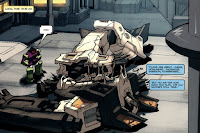I'm not sure why I decided to re-read the IDW comics in chronological order but at this point it stops making much of a difference, because this is where the meat of the continuity begins. In a way it's a perfect preview of the company 'so output, being readable but avoidably flawed. After 20 years of dealing with the whims of others at Marvel and then Dreamwave, Simon Furman finally had a blank canvas to show us all how he could mould the Transformers from the ground up. What follows shows his talents off while exposing his weaknesses to an almost cruel degree.
What's good is the clear attempt to reasonably plot out the processes involved in Decepticons invading a planet, and how the Autobots would counter this while also establishing a perfectly good rationale for both factions to remain low-key and in disguise. The whole idea of the Infiltration Protocols is bluntly a writing masterstroke that is unequalled in the franchise's fiction, even topping the Cybertronian Empire pull-back of the Generation 2 comic.

The players are also expertly chosen, the cast carefully blossoming from Ratchet (initially largely seen as an ambulance which communicates via a holomatter avatar) and the Battlechargers to a decent roster of favourites, enough of whom receive good characterisation to lay a workable foundation. The series' glacial pace is also less of a problem in a solid read-through, which - in either digital or trade form - is the only way anyone's read the story since 2006. And E J Su's art largely retains its punch; the clean Binaltech-influenced designs (which - it is easy to forget - preceded the similarly practical visual ethos of the Paramount films) are a delight and his kineticism is up to every challenge the script puts his way.

However, the series - and thus the whole continuity ahead of the soft reboot of Furman's effective removal from the title in 2008 - is flawed on a genetic level. The problem being that Furman is an epic plotter but a kids' comic writer. It's not even his dialogue for once, which aside from a couple of fumbles (Hunter phonetically spelling out his surname in a conversation when he's just said it out loud and thus phonetically anyway stands out as the only really dumb moment) is restrained and even largely maintains the intended mood in its functionality. No, it's the mental incapability to throw away the rulebook, a rulebook that - with a fresh sheet of paper and Hasbro in a "whatever, just give us money" mood - only existed in Furman's own limitations.

The most evident problem are the three main human characters. I have no inherent problem with humans in Transformers fiction, and the idea that a major arc could take place on Earth without some interaction between species closes down many promising angles. The problem here is that all three are not only largely uninteresting but that they're basically child identification figures - like Spike and Sparkplug from the eighties cartoon, or Rad, Alexis and Carlos from Armada or something. In a comic surely aimed at nobody aged under 16 and conceptually tooled as a sleek, modern adult-orientated attempt to break free of previous comics' restrictions. That they're in their late teens or early twenties rather than at school makes little difference.

The characters are as follows: spunky orphaned runaway Verity Carlo, who drifts from place to place thanks to her pickpocketing skills and tech savvy ; Hunter O'Nion, a nerdy conspiracy theory enthusiast and Jimmy Pink, whose character is that he's a mechanic and that he provides a flat neutral middleman in Verity and Hunter's discussions. Verity is largely inspired by Jubilee of X-Men fame, or at least the best known pre-Generation X version - attitude and repeated declarations of self-dependency proving lazy shorthand to show the reader that she's not your average comic bimbo, Hunter is Fox Mulder Junior, Jimmy is just there. Both indicate a writer who lost touch with the generation he's trying to write in about 1997.

To be fair the big problem with these three kids is that the debut arc ended up being the meat of their appearances. Lukewarm reaction saw Furman and/or IDW lose faith in them as major characters fairly quickly and not only would the second arc (Stormbringer) market itself on their absence but the third and fourth would write them out with only moderate decency. That's not really Infiltration's fault exactly, but then the series has plenty of others.

If it can be summed up in one cheap shot it's that Furman talks the talk but can't walk the walk. There are several opportunities to show that this is a brave new comic where everything you know before is void, and they're all fumbled. Despite almost painful attempts to justify it in the story, we still have three kids snooping in a Decepticon base like something out of a Saturday morning cartoon. Even then there's a chance for a statement to be made - Bumblebee describes the intrepid trio as acceptable casualties and it's clear the Autobot doctrine on Earth means their lives are a minor priority weighed against the other six billion on the planet. But it's empty bravado - a last minute escape from a Decepticon air strike comes panels after a super sequence where Megatron spots Verity and instantly dismisses her as an insect not worth caring about. Killing off one of the humans - even third wheel Jimmy - would have been a fantastic way of declaring that all bets were off.

However, the poster child for such squandering is the Megatron/Starscream dynamic. The original comic had largely avoided the cartoon's stupidity by the pair rarely being front and centre at the same time for much of its' run. While their textbook relationship was revived for Generation 2 it had a fair bit of necessity to justify it, the odd wry lampshade hung on it and the inescapable factor of both being on the toy shelves. Here, Starscream - hyped up on the Ore-15 superfuel that provides such a good reason for setting the action on Earth - tries to draw Megatron into a showdown by repeatedly breaking his leader's cherished protocols. Megatron declares that he's had enough of all this treachery derailing the Decepticon cause and goes to put his house in order.

He shoots down the conspiring Skywarp and Blitzwing, then heads to Starscream's nest. There then follows a scene of minor genius as the Autobots look on while Megatron instantly cows Starscream's handful of followers before setting to work on the backstabber himself. There is then a brief but well drawn battle where Starscream proves no match for Megatron even with Ore-15.
So there's Starscream the traitor, smashed to bits by the new no mercy Megatron. Fatality, right? We're going to see this new no-nonsense Megatron brutally take out Starscream to show it's not the same old story... No, wait, he's still alive and Megatron is going decide what to do with him later. Which we already know is more likely to involve banishment to an asteroid than summary execution because Furman's still using the same old tired dynamic and is too scared to kill off a popular character early doors and scare the traditionalists. Instantly undermining any pretentions that this is a brave new universe or that this is finally a Megatron to be taken seriously.
Talk talked. Walk not walked.
■■■■■□□□□□
 This issue is actually about further setup for the Ark-1 plot opened in Spotlight Nightbeat. It's difficult to evaluate this in hindsight, given that we know now how badly that would turn out but it's certainly not as interesting as it should be and definitely something that could have waited six months while other threads were tied up. It's also the start of mainline plots bleeding into the Spotlights, making them less character pieces and more an overflow system for the "core" plots.
This issue is actually about further setup for the Ark-1 plot opened in Spotlight Nightbeat. It's difficult to evaluate this in hindsight, given that we know now how badly that would turn out but it's certainly not as interesting as it should be and definitely something that could have waited six months while other threads were tied up. It's also the start of mainline plots bleeding into the Spotlights, making them less character pieces and more an overflow system for the "core" plots.  Really this is more about Furman "doing" the combiners than a story about Optimus. It's one of several IDW issues to just grind to a halt while the writer lays out his theories about how some eighties toy gimmick or another works in his universe. It might not have been so bad if the answer wasn't always "an evil scientist did it and it resulted in a nutter".
Really this is more about Furman "doing" the combiners than a story about Optimus. It's one of several IDW issues to just grind to a halt while the writer lays out his theories about how some eighties toy gimmick or another works in his universe. It might not have been so bad if the answer wasn't always "an evil scientist did it and it resulted in a nutter". 









































